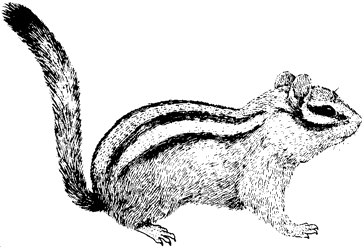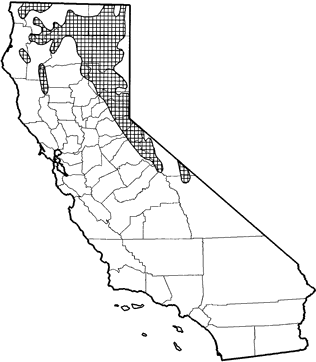
Yellow-pine Chipmunk
Distribution, Abundance, and Seasonality
Common yearlong resident of open stands of most coniferous forest habitats, montane hardwood, montane hardwood-conifer, pinyon-juniper, and many Great Basin shrub habitats from the central Sierra Nevada north to the Cascade Ranges, Modoc Plateau, and Warner Mts.

Range Map
Specific Habitat Requirements
Feeding: Yellow-pine chipmunks primarily are herbivorous. They eat seeds of conifers, shrubs, forbs, and grasses; they also take fungi, fruit, and insects. Forage on the ground, and also in trees and shrubs. Carry food in cheek pouches to caches in burrows for use in winter (Broadbooks 1958).
Cover: These chipmunks utilize intermediate and low canopy-cover stages in forest habitats, and intermediate and dense stages in shrub habitats. Require shrubs, ground litter, rocks, snags, stumps, and logs for resting cover.
Reproduction: These chipmunks nest in logs, stumps, snags, rock crevices, or in burrows.
Water: These chipmunks probably meet their water needs from food.
Pattern: Suitable habitat for yellow-pine chipmunks is in areas of open, brushy forest with a ground cover of rocks, shrubs, forbs, and litter. Scattered sources of water enhance the habitat.
Species Life History
Activity Patterns: Diurnal; become torpid in their burrows during winter, and may arouse occasionally to feed on stored food (Maser et al. 1981).
Seasonal Movements / Migration: Non-migratory.
Home Range: Home range in the Cascades averaged 0.4 to 1.5 ha (1.0 to 3.8 ac) (Broadbooks 1970). In Alberta, male home range averaged 1.3 ha (3.2 ac) and varied from 0.4 to 2.8 ha (1.0 to 6.9 ac); female home range averaged 0.6 ha (1.4 ac) and varied from 0.1 to 1.1 ha (0.2 to 2.7 ac) (Sheppard 1972).
Territory: Apparently defend only the vicinity of the den.
Reproduction: These chipmunks breed from April to late July. First births occur in May, most occur in June. Last lactation occurs in July. Gestation averages about 30 days. Litter size 3-8; one litter per yr.
Niche: Potential predators include long-tailed weasels, bobcats, coyotes, minks, hawks, and owls. In California, this chipmunk is sympatric in portions of its range with 9 other species (T. minimus, T. senex, T. sonomae, T. quadrimaculatus, T. speciosus, T. siskiyou, T. alpinus, T. panamintinus, and T. umbrinus). Yellow-pine chipmunks often are found in association with golden-mantled ground squirrels.
Sources & References
California Department of Fish and Game, 1999.
California's Wildlife, Sacramento, CA.
Written by: T. Harvey, C. Polite, reviewed by: M. White, edited by: M. White, C. Polite
Broadbooks, H. E. 1958. Life history and ecology of the chipmunk, Eutamias amoenus, in eastern Washington. Univ. Michigan Mus. Zool. Misc. Publ. 103. 42pp. Broadbooks, H. E. 1970. Populations of the yellow pine chipmunk, Eutamias amoenus. Amer. Midl. Nat. 83:472-488. Maser, C., B. R. Mate, J. F. Franklin, and C. T. Dyrness. 1981. Natural history of Oregon coast mammals. Pac. Northwest For. And Range Exp. Sta., USDA, For. Serv., Gen. Tech. Rep., PNW-133. 496pp. Sheppard, D. 1972. Home ranges of chipmunks (Eutamias) in Alberta. J. Mammal. 53:379- 380.
California Animal Facts | California's Wildlife